by CMDR Rick Westoby, OAM, RAN
Past History of the Site
The site of HMAS Waterhen, on the shoreline of Balls Head Bay, sits within the traditional land of the Cammeraygal (Gammeraigal) people, one of seven clan groups who lived around the edges of Sydney Harbour on the north and south sides. The Cammaraygal’s land, including Balls Head, extended east to Cremorne Point, west to Woodford Bay and north towards Turramurra. Archaeology from around Cammeray dates the occupation of the lower North Shore back at least 5,800 years, although with dates of up to 30,000 years around Parramatta, it is likely that people lived in and around Balls Head for longer than the local dates suggest.
Evidence of human occupation of Balls Head is particularly strong for the Sydney region. A large midden site was excavated in the 1970s to a depth of 1.2 metres, while a series of rock engravings hint at this site’s spiritual and totemic significance for the Cammeraygal. Over 450 stone artefacts— including flakes as well as worked pieces—were recovered, as were some glass pieces, suggesting that the site continued to be occupied after European arrival in 1788. Indeed, Aboriginal people were still camping periodically at Berrys Bay, the next bay to the west, until the 1870s.This may also have been occurring on parts of Balls Head, as it was undeveloped and relatively remote through much of the nineteenth century. The midden site was primarily made up of rock oysters, hairy mussels and Sydney cockles, often associated with food collection by Aboriginal women. Archaeologists concluded that the mix of women’s artefacts and more-traditionally male artefacts related to stone tool production, suggesting a site of mixed-gender use. The burial of an Aboriginal woman in the midden at Balls Head was also discovered during the excavations on the site and is also the site of a series of Aboriginal rock engravings. These include a human or ancestral figure, fish and a large whale with a man inside. Some Aboriginal people suggest this figure represents a clever man, with the whale figure carved high on the escarpment giving a view of the harbour to allow the whales to be sung in for the people.
Colonial History
It was widely recorded in the accounts of early colonial officers, diarists and letter writers that the Cammeraygal were important in law and ceremony around the harbour, and would often preside over initiations and other traditional gatherings. One of the men was Carradah, who met Lieutenant Ball, after whom Balls Head is named. Ball and Carradah swapped names, an indication of the closeness of their friendship. Barrangaroo was a prominent Cammeraygal woman in the early colony and the wife of Bennelong.
Balls Head, named after the officer Lieutenant Henry Lidgbird Ball, Captain of HMS Supply of the First Fleet, was a prominent, rocky peninsula fronting a deep-water bay, one of a series of outcrops on the northern shore of the harbour. HMAS Waterhen is located on the eastern shoreline of Balls Head Bay, within what was the colonial estate of the business partners and colonial traders Edward Wollstonecraft and Alexander Berry.
Wollstonecraft and Berry had arrived in separate ships in Sydney in 1819, and established themselves as merchant traders in lower George Street, near the wharves of the growing colonial town, where they built a warehouse and ran their business. In 1820, while Berry
was in England arranging new cargos for the colony, Wollstonecraft appealed to Governor Macquarie for some land for both men, stating that both intended to settle in the colony. They were duly granted 2,000 acres each, with Wollstonecraft having 524 acres of his total grant located on the lower North Shore. To this portion he gave the name ‘Crows Nest Farm’ and built a house overlooking the harbour. Berry returned to Sydney in 1821, and together with Wollstonecraft, successfully applied for a further 10,000 acres of land which they located on the Shoalhaven River. This new estate, which Berry named Coolangatta, was rich in timber such as cedar, and when cleared, was used for growing tobacco and other agricultural products. The partners split their time between North Sydney and Coolangatta, ensuring one or the other was always at each place.
Although Coolangatta was increasingly productive, the poor quality of the soil and the rugged nature of the foreshores at the Crows Nest Farm meant little was developed across the estate before Wollstonecraft’s death in 1832, save for some quarries and the cutting of timber to sell. By then, Berry had married Wollstonecraft’s sister Elizabeth (in 1827) and the Crows Nest estate had passed to him. By 1837 he had managed to increase the estate to over 800 acres and had erected a new house for himself and his wife in what is now the North Sydney CBD. After his wife’s death in 1845, Berry retreated to the house, becoming a recluse, and leaving the on-site running of his estates to his brother David.
Due to the unproductive nature of much of the Crows Nest Farm, Berry had been subdividing and selling portions of it since the 1830s and, by 1846, the population of the area was recorded as 412. Berry had donated land for St Thomas’ Church to be built and set aside a portion for a cemetery. Taking advantage of the small but growing interest in the area, Berry further subdivided his estate from 1853, with the gradual development of the town of North Sydney from 1854. In 1867 the area was incorporated as the Borough of St Leonard’s, despite Berry’s opposition.
While development was slow to take hold on the headland, the deep water of Balls Head Bay offered some possibilities for industrial progress. Soon after taking up the Crows Nest Farm, Wollstonecraft built a warehouse on the eastern shore at the head of Balls Head Bay, around which a collection of boatbuilding and repair yards developed through the 1820s and 1830s. These were joined by Robey’s Sugar Works at Oyster Cove in the 1830s, but the foreshore of the headland remained free from industrial development, locked up in the Berry Estate until the first years of the twentieth century. Although Berry died in 1873, aged 92, the Crows Nest Farm remained largely intact as it passed through family hands until 1909, when the death of Berry’s cousin—by then owner of the estate—Sir John Hay resulted in the property being subdivided for sale. Part of the shoreline of the Waverton peninsula was set aside during World War I to be developed for a coal handling facility, from 1916. But it was not until the end of the war that serious work began to take place.
By May 1919, work had progressed on the ‘Coal Loader’ site, with foundations for the loading facility in place, and construction completed on retaining walls and tunnels for the railway system on which loading cranes could travel above the coal bunkers and a large finger wharf on which coal was stored, loaded and unloaded. The coal facility operated into the 1990s. Adjacent to the site from 1953, first Golden Fleece and later Caltex (1981) operated a storage depot for lubricating oil, with large oil tanks erected along the shoreline, adding to the industrial development of Balls Head. The headland itself though was spared, having been set aside as a public reserve in 1923. Its exclusion allowed for bushland regeneration across the area, until it resembled a pre-1788 landscape.
Military History of the Site
At the outbreak of World War II in 1939, Sydney Harbour, with its navy base at Garden Island and dockyard on Cockatoo Island, was a major defence site for Australia’s war effort. While the defence sites were put on a war footing from 1939 it was increasing tensions in Asia and the looming possibility of conflict breaking out closer to Australia that transformed the harbour.

From Balls Head, ca 1930. The coal loader is on the right
it was increasing tensions in Asia and the looming possibility of conflict breaking out closer to Australia that transformed the harbour.
In May 1940, Prime Minister Robert Menzies announced that a dry dock capable of taking the largest capital ships for repairs and refit would be constructed as part of the Garden Island naval base in Sydney. The dock would provide repair and refit facilities not only for Australian Navy ships, but those of friendly nations as well without the need to go all the way to the docks in Singapore, at the time the only such facility in the region. The construction would include a graving dock, as well as reclamation of the part of the harbour to connect the island to the shore, allowing for the expansion of the naval facilities and easier access to the base. One of the first tasks was the construction of a large cofferdam from which the sea water was pumped, providing a dry area to build the dock.
This dam was started in December 1940 and completed by February 1942, by which time Australia was at war with Japan and Singapore had fallen to the enemy. To provide material for the dam, the NSW Department of Public Works opened a new quarry at Balls Head. By the end of June 1941, 100,000 cubic yards of rock had been taken from Balls Head for the coffer dam, with a total of approximately 410,000 cubic yards of sandstone taken when the quarry closed in July 1942.
The quarrying operation left a large, flat foreshore with towering cliffs behind and was taken up by the Department of Defence for the construction of a new naval base for the operation of the Sydney Harbour boom defences. As a major naval base for both the RAN and for the fleets of the allied nations fighting in the Pacific, including the American and Royal navies, Sydney was considered a target for Japanese attacks and raids. With submarines a particular threat, the harbour was to be defended in part by a submerged anti-submarine and anti-torpedo boom, which stretched between Georges Head on the north

Quarrying stone at Balls Head in 1942 for the construction of the Captain Cook Graving Dock at Garden Island
side and Laings Point on the south. The system was made up of 57 individual nets, strung together. All ships and ferries entering or leaving the inner harbour had to travel through one of three gates in the boom net. The boom was commenced in January 1942 and fully operational by August.
On 31 May 1942, two months prior to it being completed, Sydney was attacked by three Japanese midget submarines. Of the three, one was caught in the western end of the boom, although the other two managed to access the inner harbour, sinking HMAS Kuttabul in the ensuing attack. At Balls Head, the boom defence base was built through 1943–1944, initially as a joint Royal Australian Navy (RAN) and United States Navy site, before being taken over completely by the RAN in 1943.
The first major task was the construction of an access road from the heights above down to the waterfront. This is now known as Waterhen Drive. It runs from Balls Head Road. A series of store buildings, administration and accommodation quarters for sailors were constructed across the base, with wharves built for ships to dock at in Balls Head Bay. At the end of the war in 1945, the boom nets were raised and returned to the Balls Head site to be cleaned and stored. The site remained in use as a boom defence facility until the early 1960s, coming back into readiness with the outbreak of the Korean War in 1950 as two boom defence vessels, HMAS Kangaroo and HMAS Koala, were stationed there. Training in boom defence was ongoing through this period. However, by 1960, the submarine threat to harbour sites had been largely superseded by new missile technology and the boom defence site was no longer required.
History of the Name — Waterhen
The original Waterhen (I) was one of the V&W-class destroyers (Waterhen (I), Vampire (I), Vendetta (I) and Voyager (I)) loaned by the Admiralty to the Royal Australian Navy in 1933 as a replacement for the S-class destroyers Stalwart, Success, Swordsman, Tasmania and Tattoo). The destroyers were commissioned into the RAN at Portsmouth, England on 11 October 1933 to form the Destroyer Flotilla, later to become famous as the ‘Scrap Iron Flotilla’. Waterhen is the second commissioned unit to carry the name. The first, the ‘Chook’, as she was affectionately known by her ship’s company, was built in England in 1918. After transfer to the RAN in 1933 she was in and out of reserve before being re-commissioned for war in September 1939. Waterhen (I) spent the following six years either serving on the Australian Station or in Reserve. Following the outbreak of war, she was recommissioned on 1 September 1939, and her first wartime duties were anti-submarine patrols based out of Sydney, alternating with HMA ships Stuart (I) and Vendetta (I).
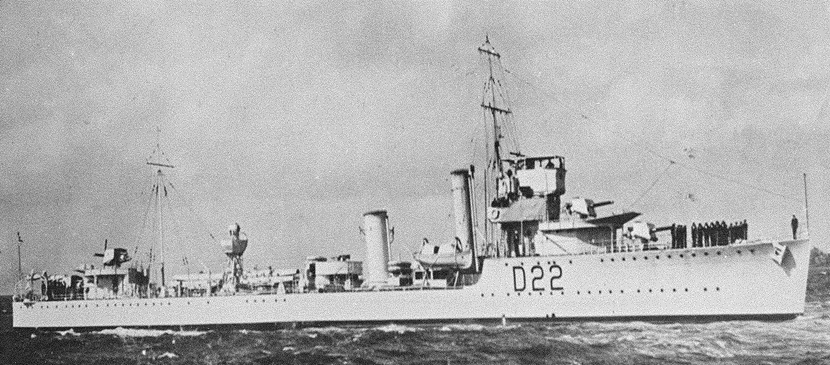
The first HMAS Waterhen
Waterhen (I), with her sister ships Stuart (I), Vendetta (I), Vampire (I) and Voyager (I) became famous as the ‘Scrap Iron Flotilla’ in the Mediterranean. The title came from Goebbels who called them scrap iron. He welcomed them to the Mediterranean in that bleak, cold December of 1939 as a ‘consignment of junk’ and Australia’s scrap iron flotilla”, ridiculed their fighting power, scoffed at their age and infirmities. Off course, there was a germ of truth in the statement. They were old. They weren’t very big, or very fast, or very powerful. They had been laid down and completed in 1918 when ships were slow and aircraft still in their infancy.
As part of the Australian Destroyer Flotilla, from 2 January 1940 Waterhen served with distinction in the Mediterranean. On 28 June 1941 she left Alexandria for Tobruk with HMS Defender on what was to be her last run. The following evening at 1945, both ships were attacked by dive-bombers and Waterhen was holed and immobilised, incredibly there were no casualties. She was taken in tow by HMS Defender, however it soon became apparent that she could not be saved. At 01:50 on 30 June 1941 the ‘Chook’, as she was affectionately known to her crew, sank (without the loss of life) and became the first RAN ship to be lost by enemy action during World War II.
HMAS Waterhen the Base
With the advent of World War II, the site was filled and a number of ‘temporary’ fibro buildings were constructed. The site was utilised as a Boom Defence Depot where they stored the ‘booms’ (steel nets for underwater use to stop enemy submarines from entering the Harbour). It was a joint RAN/USN facility from 15 March 1943 to 30 June 1943, then under RAN control from 1 July 1943.
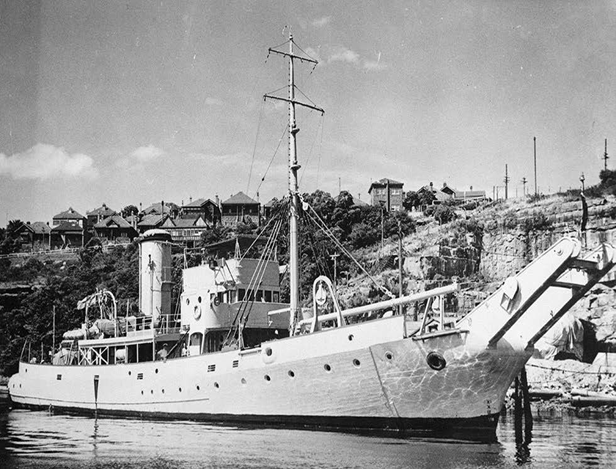
HMAS Koala alongside at the Balls Head Boom Defence Depot
After World War II the site reverted to a storage depot until HMAS Waterhen was commissioned on 5 December 1962 to serve as a support base for the six Ton-class mine sweepers, HMA Ships Teal, Ibis, Snipe, Gull, Hawk and Curlew, acquired from the Royal Navy in the 1960s. This was the first small ship base of this nature and was also home to the Mobile Clearance Diving Team. With a complement of 85 officers and sailors, the base had no accommodation, so the River-class frigate HMAS Culgoa was relocated to the northern wharf and put into use as a barracks ship.
On 5 December 1962, the former boom defence site was commissioned as a new Mine Sweeper and Mine Hunter (mine countermeasures) RAN shore base to be called HMAS Waterhen, after the ship of the same name. The HMAS Waterhen shore base was to accommodate the newly-acquired Ton–class mine sweepers and mine hunter vessels with Attack-class patrol boats added to the base in 1968.
Initially, HMAS Waterhen occupied the existing World War II era buildings of the boom defence units, but by 1968, when the new patrol boats were being added to the base, work had begun to upgrade the facilities. At this time, the base was home to the 16 Mine Clearance Squadron, including ships HMAS Teal, Ibis, Hawk, Gull, Snipe and Curlew, and the patrol boats HMAS Advance and Samarai, making a total of 462 sailors and 60 officers on the base at any one time.
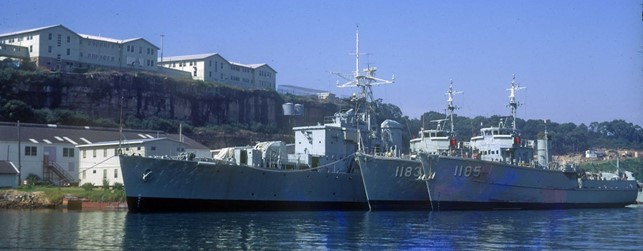
The frigate Culgoa, as accommodation ship, with the minesweepers HMAS Ibis (1183) and HMAS Gull (1185) alongside
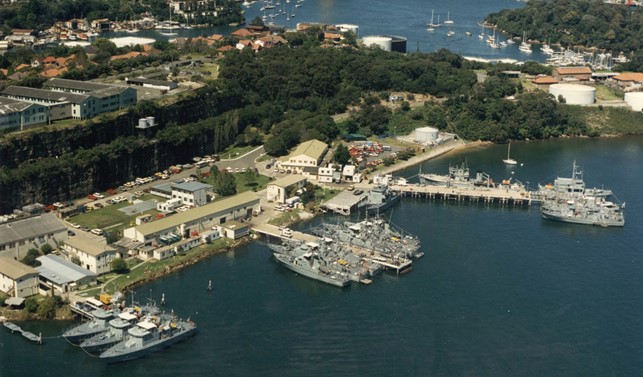
HMAS Waterhen with three Pacific Patrol Boats, four Fremantle-class patrol boats, two Attack-class patrol boats, one Ton-class mine- sweeper (HMAS Curlew), two catamaran minehunters (HMAS Rushcutter and HMAS Shoalhaven) and two diving tenders alongside
In March 1969 Waterhen became the first base for the Attack-class patrol boats (ACPB) and the Commanding Officer Waterhen also became Commander Australian Mine Warfare and Patrol Boat Forces (COMAUSMINPAB). The ACPB were superseded by the Fremantle-class patrol boats based at HMAS Cairns and the Darwin Naval Base.
The role of COMAUSMINPAB was divided into Commander Australian Patrol Boat Force (COMAUSPABFOR) who relocated to Cairns, and Commander Australian Warfare Force (COMAUSMINFOR) who remained as Commanding Officer Waterhen. COMAUSMINFOR was subsequently changed to Commander Australian Mine Warfare and Clearance Diving Forces (COMAUSMINDIVFOR), a more complete reflection of the composition of the Australian Mine Countermeasures Force.
In addition to the formation of COMAUSNAVMCDGRP, the RAN’s Mine Warfare and Clearance Diving capabilities were upgraded to include the Mine Warfare Systems Centre and six Huon-class minehunters. It soon became apparent that the 50 year old temporary fibro buildings and two existing wharves at could not support the mine countermeasures forces of the future.
The main issue for the base was accommodation, and from 1968 a long process of upgrading the base began, with disagreements between the navy and the Commonwealth Department of Works on how to proceed. The then Minister for the Navy (DJ Killen) commented on the 22 May 1970: ‘With considerable reluctance I have approved two appropriations which relate to the expenditure at HMAS Waterhen. I would like it understood that I see no future in maintaining Waterhen. I believe the Waterhen surroundings dismal, extremely shabby and offer very little opportunity for expansion. Having regard that current considerations is being given to removing patrol boats from Waterhen, I hope every encouragement will be given to ensuring that Waterhen has a diminishing role.’
Although these buildings were delayed, other works began at the base in 1969–70. This included the construction of a new access road, a new wharf and the conversion of two buildings to form a workshop and naval stores. Wharf facilities and hydraulic systems were also upgraded.
As a temporary measure, the then Base Commander requested prefabricated, temporary buildings to serve as cafeteria and recreational space while plans for permanent buildings were being approved. The Commonwealth Department of Works resisted the plan, claiming the buildings would despoil the natural beauty of the foreshore, a claim dismissed by the Base Commander who commented on the natural beauty of the coal loader, fuel storage tanks, gasworks and factories already along the foreshore around the base.
As well as the work undertaken, the main concern was accommodation and plans for a new administration building, squadron offices and classrooms were submitted to the Commonwealth Department of Works. It was also proposed to upgrade two on-site buildings (Buildings 1 and 2) to act as an administration block and to extend and convert the naval stores building for use as victualling stores and offices, common canteen and recreation rooms.
In May 1969, civilian contractors were working on alterations to the administration building. The navy personnel living in on-site accommodation moved to the naval stores and to Culgoa; however, the on- base living arrangements were considered so bad that some sailors chose to live in accommodation off-site rather than stay in a RAN house. Problems with the development of the administration building increased the levels of frustration on the ageing base, with Captain Ian Wilson, Commander in 1970, being officially reprimanded in March for his comments made in reports on the state of the works. By then, the new administration building was only just completed but had already been determined as not fit for purpose and required new plans for additions to be made.
Plans for a mezzanine addition were commissioned in February 1971. Further to this, Culgoa had been condemned for sailor accommodation, adding extra pressure to the already overstretched accommodation on the base. With work also required on the naval stores building, in late 1970 the secretariat offices were transferred and work started on refurbishing the naval stores in October. Work had also begun on replacement buildings for Culgoa, with concrete foundations poured around the same time. As naval stores were being refurbished, a former concrete lighter Porpoise was put into use, along with 10 shipping containers to be used as storage. Work was ongoing through 1971, with three Lysaght steel accommodation buildings erected on the base.
In July 1971, all personnel were off Culgoa and into new accommodation; Culgoa had been removed from the base in June, and the Base Commander reported that no-one was sorry to see her go. By the end of 1971, the naval stores building including the mezzanine level had been finished and handed over, a new laundromat was finished and work had started on a new flammable store. As part of the ongoing upgrade, the foreshore was also graded and a new stone seawall constructed to the south of what was known as the minesweepers wharf. The stone was recycled from the demolition of a 1870s house in Parramatta.
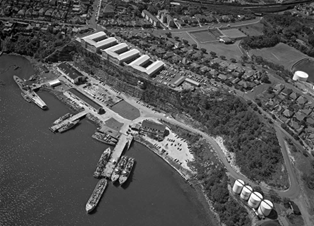
HMAS Waterhen before redevelopment, with Culgoa still along- side (top left)
Improvements to the duty watch accommodation, recreational and mess facilities improved morale across the base by the end of 1971. Works through 1972 included the fit out of the naval stores, the completion of the flammable store, the seawall, the upgrade of the base septic system and a new entertainment space for personnel.
By April 1973, an upper floor extension of the former administration building was complete and a one-ton hoist installed into the stores building. New stormwater drains were also installed across the southern end of the base by October 1973. The upgrades, although welcomed, were still at capacity through 1974 as 19 separate ships were given assistance at the base.
A masterplan had been suggested as early as 1969, and the decision by government in 1974 to retain Waterhen as a permanent naval facility only added to the urgency for an overall site plan. This urgency increased after the arrival of the Fremantle-class patrol boats in the early 1980s, which required further expansions to the base facilities.
By 1986, Waterhen had two main wharfs extending into Balls Head Bay, as well as a floating pontoon, small wharves and quay for boats to secure. Three main buildings housed the base stores, administration and offices (1, 2 and 3), with a collection of portable buildings, shipping containers and other temporary accommodation being utilised across the site.
Around 1991 the elevated, eastern portion of the site was handed to Defence for use by the NSW Government and Waterhen came under command of Commodore Carolyn Brand. Three large U-shaped buildings that had occupied this upper level since ca 1964 were subsequently demolished between 1994 and 1996.
After 30 years Waterhen was about to have a radical facelift. The Modernisation Project commenced in December 1994 with the demolition of buildings at the northern end of the base and in the months to follow the entire base was levelled and the existing wharves removed. Throughout the modernisation, staff managed to maintain an operational base. The core administrative staff worked out of various temporary structures, which had a somewhat shorter lifespan than Waterhen’s original temporary buildings. Some lodger units were also temporarily relocated to other establishments, the project was completed in December 1996, eight months ahead of schedule and at a total cost of $70 million.
During the same period, the waterfront buildings at Waterhen, some of which had been left over from World War II and the 1960s–70s development, were all removed and three new, consolidated buildings erected. Building 1, at the northern end of the site, housed offices and administration; Building 2 in the centre housed supply and diving operations; and Building 3 at the southern end comprised workshops. In addition to the new buildings, two new main wharves were built, as well as a small boat wharf and a concrete ramp into the bay. A multilevel carpark was erected behind Building 3, with a collection of ordnance stores, oil storage, a flammable goods store and other operational facilities at the southern end of the site. A new seawall was also built along the entire waterfront of Waterhen, slightly extending the reclaimed area into the bay. This was the last major upgrade to the base and represents the current layout of the site.
In early 2000, following a broad restructure of the Navy, the command developed into Commander Australian Navy Mine Warfare and Clearance Diving Group (COMAUSNAVMCDGRP).
In recent years, HMAS Waterhen has been home to HMA Ships Rushcutter and Shoalwater, the Bay- classAustralian-designed mine hunting catamarans which replaced the Ton-class mine countermeasures vessels. On 14 August 2001, these vessels were decommissioned and on 11 September 2001, they finally left the wharves of HMAS Waterhen for Spectacle Island.
Today, Waterhen is home to four Huon-class mine hunter coastal vessels, HMA Ships Diamantina, Huon, Gascoyne and Yarra. Waterhen is also the home to a busy flotilla of support craft—the Aviation Training Vessel (ATV) Sycamore, the Diving Tender (DTV) Seal, the VIP Squadron for the Fleet Commander and the home of the LHD landing craft when not on the LHDs.
The new Waterhen complex comprises of three main buildings, two new wharves, a small boat jetty and boat ramp, a four-level car park (196 car spaces), a bulk-fuel installation, a gatehouse and a magazine. The two main buildings each consist of three levels and house Waterhen and COMAUSNAVMCDGRP support staff, the new Mine Warfare Systems Centre, AUSCDT ONE, Team 16 and the Mine Warfare Faculty. The third building houses Fleet Support Unit Waterhen. To appreciate the magnitude of the transformation of Waterhen consider that Building One alone contains more floor space than the entire Waterhen pre-modernisation.
In 2016, a fast roping tower was installed at the rear of Building 1, adjacent to the cliff face. This structure is required to train RAN personnel the technique for descending down a thick rope at speed, accurately and safely (e.g. with loads/weapons). In 2019 a new small craft wharf was completed for Team 16 to house their small craft for autonomous MCM operations.

HMAS Waterhen in February 2018 with an oil lighter, the navigation training ship Mercator, two Huon-class minehunters and five LHD landing craft alongside the two main wharves. Building 1 is on the left, with the small boat jetty and boat ramp on the right




